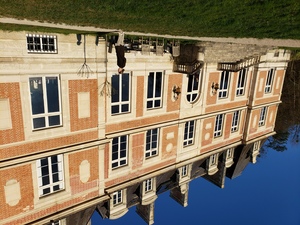
Now that my art residency is over, I feel comfortable posting about it. This will actually be a series of posts, launched as I can get to them.
The residency at Chateau d’Orquevaux *can* be a career advancing, life changing experience for the right creative person.
At the very least, for what you pay, it’s a great vacation in a lovely rural area of Northeastern France.
Having chosen a 3-week stay as more immersive, I can discuss some of the positives and negatives to an Orquevaux residency. Your mileage may vary!
This first post will be divided into two parts: Environment and Art.
The Environment:
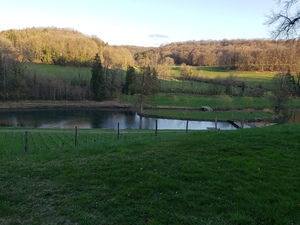
Orquevaux is a jewelbox of a tiny town set in a hilly valley above the equally tiny (little more than 13km long) river La Manoise. A nature preserve runs northeast of the town, amid bands of open farmland and managed forests.
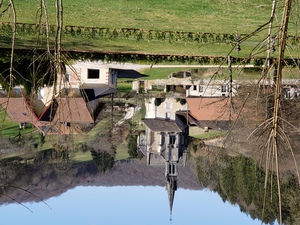
Do not be fooled by Google Maps; most of this town is built on hillsides with steep roads. A former ironworking center, the houses show old wealth in their brick and stonework, wrought iron, and carved stone statues. Orchards and gardens can be seen beyond fences.
In addition to the Chateau, there is an elegant small Castel now operating as a bed & breakfast, a few smaller manors built in the Chateau style, and an exquisite spired church. All great sketching subjects!
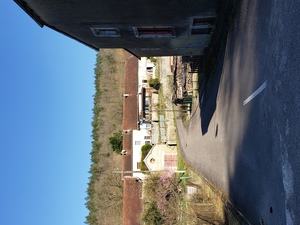
First, if you have any dietary restrictions or hindrances to physical movement, you might want to rethink this. Or at least plan ahead! Seriously consider creating an Amazon France account for emergency supplies.
Bring *all* needed medications. Bring pain relievers, bandages, sewing repair kits. Shampoo & shower soap is provided, but you may want to source your own.
All meals are provided. They are wonderful. The only purposeful dietary accommodation is a vegetarian entree at dinner.
I have a serious gluten allergy, so making sure which soups & sauces weren’t made with wheat was sometimes a challenge. There was always green salad, fruit, and usually a ‘safe’ meat dish. Lunch is usually leftovers. Breakfast is that Central European standard of cold cuts, pastries, bread, butter, jam, fruit, freshly hard-boiled eggs, omelets, and copious amounts of coffee. Evening desserts are glorious, even when I limited my exposure to gluten.
The next catch? If your studios are down the hill at the now horseless stables or if you room at a village guest house…be prepared for a 1000 foot walk uphill to the Chateau for meals and back. It’s good exercise for those physically able to do it.
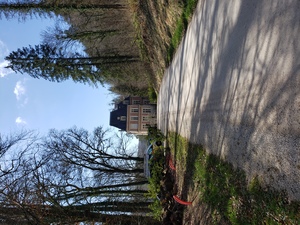
I walked a minimum of 2 miles per day.
You will probably need hiking boots with great aftermarket insoles! Also, order or bring Shoe Goo glue for when boot soles come off.
Since the driveway from the Chateau down to the stables is not lighted, a flashlight is helpful. Most of my group used their cellphone flashlight app. I carried a folding hiking/ mobility cane with a good flashlight on the front of the handle. This also helped when I wanted to explore the grounds and forest paths.
There are no ramps, no elevators, and limited space for rental cars. If you rent a car, go *small*, because Escalades aren’t gonna fit on these roads. And people will look at you funny.
Did I mention stairs? Lots of stairs! So many stairs.
You also pay a non-monetary price for the convenience of staying up at the Chateau. It’s a lovely building still being renovated in places. The walls are thin & floors (overlaid with plywood and ornate rugs) very creaky. Some rooms on the first floor are very close to the salon, where noisy parties tend to gather in the evenings (lubricated by the excellent offerings from the basement Wine Cave.) Bring earplugs, earphones, and your own music.
Quiet time in the Chateau runs from 10pm to 8am.
The stables studios have 24-hour access.
The best value, I think, is staying down in the village and working in the stables. Yes, you will walk some distance for meals at the Chateau. It helps burn off calories.
The Chateau owners are slowly buying and restoring village houses. These are charming, comfortable, with modern appliances and antique decor, and mostly quiet at night.
Some guesthouses have washers and dryers for clothing, some don’t. The Chateau has laundry facilities in the rather spooky basement. I washed a few clothes in small amounts in my guesthouse kitchen sink, and dried them on a provided folding drying rack.
Bring your own ground coffee if you don’t like dark roast. The village guesthouses have French presses, and there are coffee stations on the Chateau’s artist floors. There is copious excellent tea & decaf coffee.
For personal snacks, there are baskets in a cabinet on the Chateau first floor. (Bring silicone or reusable plastic bags to prevent pests from getting at your nibbles.) In the basement Wine Cave there are tasty snacks for reasonable prices, including chips, nuts, cheese, and some very good wine salami.
There will be a shopping trip into Chaumont on the second or third residency day. There’s a very quirky art section inside a garden center, an art supply store, a few thrift stores, and a very large LeClerc grocery store (With a sizeable gluten free aisle! And a pharmacie!)
Neither the village guest houses, stable studios, nor the Chateau have screened windows. So if you come in summer, maybe bring insect repellent and some kind of mosquito netting to sleep under if you leave the windows open. In late March, my cohort was already seeing mosquitos. Electric fans are available in the Chateau and guesthouses.
Be prepared for ticks, if you walk through grass or underbrush.
Be prepared for bees: there’s at least one hive of wild bees near or on the upper roof of the Chateau, and more scattered in the forest to the back of it.
The stables ground floor studios have amazing floor & wall spaces refinished for each residency. Like the upper Chateau floors, stable studio floors are a charming mix of practical plywood and old, ornate fiber rugs. Worktables, chairs, stools, and sofas are provided.
This was my table, an antique carved walnut beast.
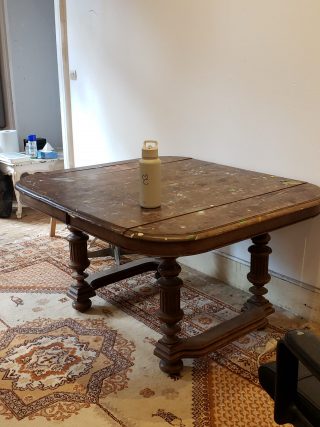
The upper stable floors are still being renovated as of March 2025, so avoid them. Except for the single studio lavatory, up a creaky flight of wooden stairs & wrought iron railings. As an added ominous bonus, note the location of old (very abandoned!) wasps nests in the upper floor rafters.
The Chateau studios vary in size from intimate to grand, based on the size needs of the artist, writer, or musician. They are all freshly repainted for each cohort.
This is a damp valley set amid forested hills, nature preserves, and vast open farmland. Expect animals! Bats and frogs are common in the evening. There’s fish stocked in the river and lake, but only the townspeople are allowed to fish there.
All manner of insects and arachnids really want to explore your space!
There’s a farm building & enclosure with sheep, goats, chickens, and giant Belgian rabbits (all pets). A large pair of swans calls the lake home, and are very territorial of the small island between the two bridges.
You cannot leave out the animal boss of the Chateau and the stables studios: an absolute ham of a large orange male cat named Dusty.
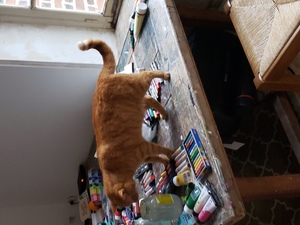
The Chateau common areas are well-appointed and comfortable, with antique furniture and decor sourced from across France. The views from the Chateau are inspiration in themselves!
The Art:
I was lucky enough to be matched with an extraordinary group of artists, writers, and musicians, in my March 13 – April 2, 2025 cohort.
They come from diverse places, backgrounds, and points in their creative careers.
We helped each other grow, challenge our preconceived notions, and (I hope) forge lifelong bonds. We watched rigidly controlled artists reach for more fluid expression, and less disciplined ones find new focus. We built new bodies of work, finished passion projects, and tried new-to-us materials.
I found it worthwhile not just on working on my own art, but in the accidental collaborations that happened because people realized I was running a sewing machine.
I set myself specific art goals at residency, and achieved most of them. First and most important: finishing ‘Wellspring’, a reclaimed wood sculpture inspired by the local river La Manoise turned into an effigy of the Solstice goddess Deer Mother. (Deer imagery is everywhere in this valley.)
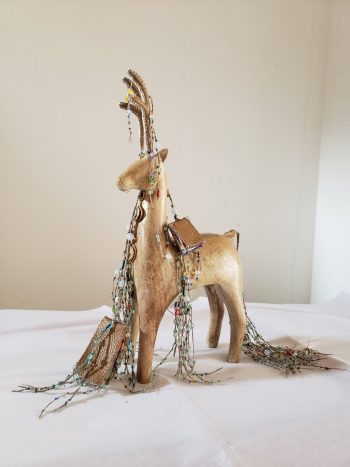
She will stay in Orquevaux as part of the Chateau permanent art collection. She was always meant to be here.
I do plan on coming back someday, possibly to focus on acrylic painting.
For acrylic and oil painters: the Chateau owners have started a small art supply store in town. The Chateau basement is also home to the Art Cave, where many previous artists have donated paints, brushes, tools, and canvas/paper rather than shipping them home.
Consider an Amazon France account for some items, but you can probably find what you need between the Art Cave, the Orquevaux supply store, or Chaumont.
Don’t bring more than one or two pieces of luggage, because you will probably have to wrangle them on a train at least once!